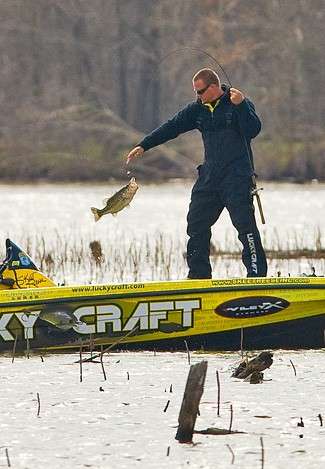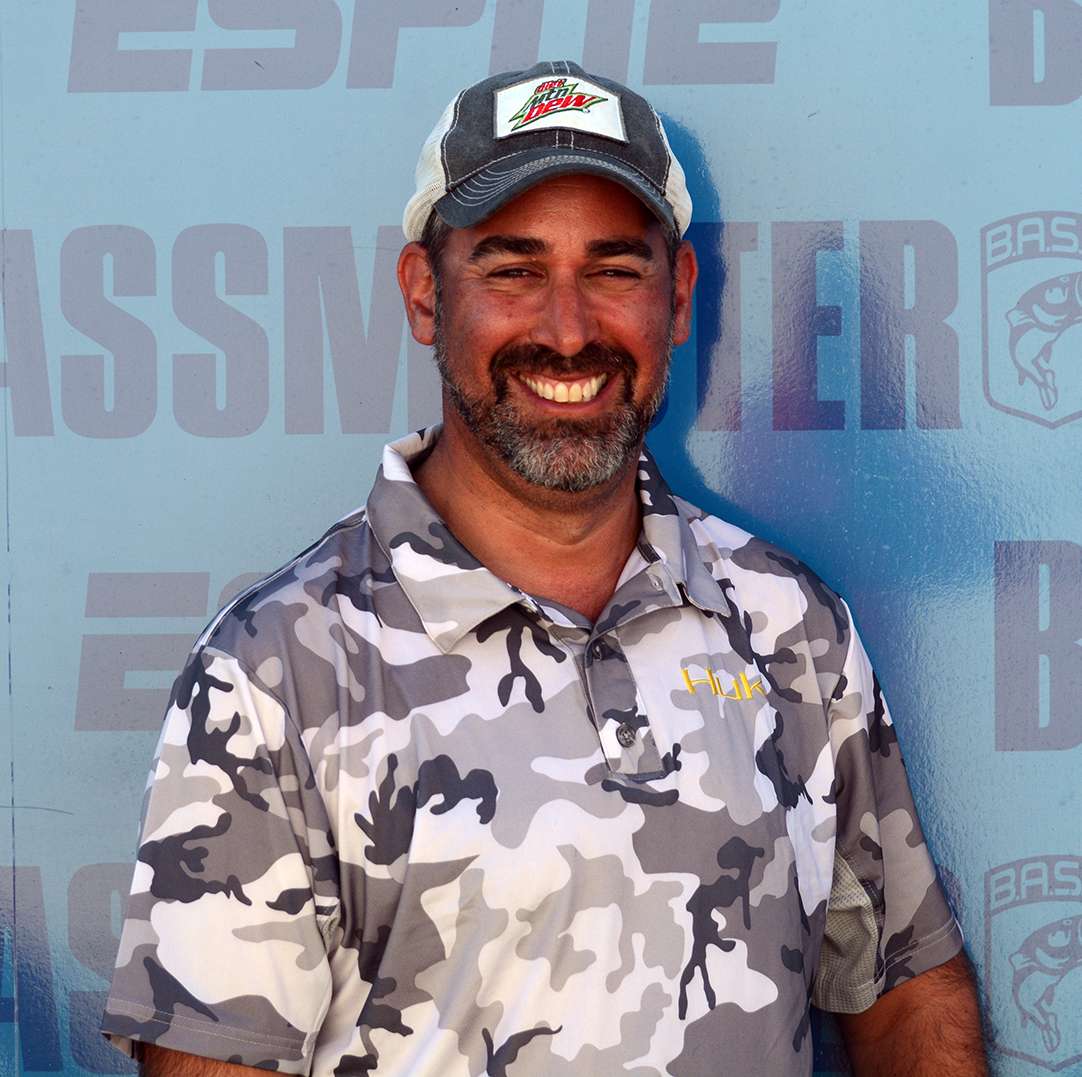
All Bassmaster Classic winners take four similar steps to claim their titles:
- They find the fish;
- They get to the fish;
- They catch the fish;
- And they get the fish safely back to the weigh-in site.
In reality, it’s not that easy, nor is it a four-ingredient recipe … the devil is in the details. The problem is that the details change from minute to minute, and even a seemingly foolproof plan can be undone by one variable that doesn’t play out as expected.
The Classic-to-Classic variables are also largely consistent – weather, mechanical breakdowns and concentrated fishing pressure seem to lead the list every year – but each Classic venue is distinct. This year’s site, Louisiana’s Red River, presents a set of challenges that are similar to other lakes and rivers, with a few distinctions that collectively set it apart.
The following are a few key factors that will almost assuredly be noted when the book closes on the 2012 Classic in Shreveport:
Fishing Pressure
While the 49 anglers will have miles and miles of river open to them, the Red is notoriously stingy when it comes to areas that produce wins. Names like “Bobo’s Hole” (named for 1997 Federation Nation Champion Dalton Bobo), “The White House” and “Sullivan’s” come up again and again. Most major tournaments in the first portion of the year are won in a specific subset of backwaters.
Chad Brauer blew away the field in a 2010 Central Open on the Red by going to a less-pressured backwater, and John Cox won an FLW event last year by pulling an aluminum boat through a culvert to an unmolested lake, but those victories were dependent on specific water levels that made the areas accessible while allowing the fish to be in a catchable mood. Such conditions are unlikely to be present this month.
Recent Classics have made crowded conditions a recurring story: Last year on the vast Louisiana Delta, most of the top finishers ended up in Lake Cataouatche, where they occasionally ended up bumping boats and watching each other catch fish. Two years ago, most of the leaders at Alabama’s Lay Lake fished in diminutive Beeswax Creek, which featured the only coontail moss to be found.
This year the leaders could be jam-packed even closer. When Skeet Reese won here in 2009, he was just a long cast from first day leader Boyd Duckett as well as several other competitors. Close friends Brian Snowden and Jami Fralick finished third and eighth respectively while sharing an area. Either might have won if he’d had it to himself.
Staking a Claim the First Day
Because the Red is likely to fish small, it’s painfully imperative that anglers stake a claim to the best of their best spots on Day One of competition. An angler whose best spot only turns on in the afternoon has to weigh making a long run in the morning only to return in the afternoon and find his area covered up with other competitors.
Even worse is to ignore a spot on Day One and then expect others to move aside on Day Two – with this much money and prestige on the line, such a move is likely to result in hard feelings and a few choice words.
Even if an angler starts on his best stretch, it’s important to find “the juice” and lay claim to it early.
Anglers like Duckett and Randy Howell fished the same bank as Reese in 2009, but when cold weather pushed the fish to one key stretch, Reese was waiting to intercept them.
Areas that Replenish
The old adage is that “you can’t win a Classic on the first day, but you can definitely lose one.” That’s why it’s so important for anglers to make their presence known in desirable areas early on. But it’s a three-day tournament and no matter how many fish a competitor catches on Day One he can only weigh in five of them.
In order to have a chance to win, he’ll need solid limits each day. Accordingly, the best areas are those that have fish coming to them.
Kevin VanDam and the rest of the Cataouatche crowd proved that last year – their area was only starting to get hot during the official practice period, but it improved steadily on each competition day, to the point where the best fishing was on the final day. Instead of dwindling, the numbers and weights were increasing.
Reese found a natural funnel for transitioning fish in 2009. That’s not to say that this tournament can’t be won on a resident bunch of fish, but the angler who counts on such a population had better hope he doesn’t arrive to find one boat – or several – fishing the same area. In that case, he’ll likely either get shut out or end up splitting up what might have been the winning creel.
Clear Water
They call it the Red for a reason. When it gets an influx of water, it flows hard and dirty – and there’s nothing worse than cold, muddy water in the early part of the year.
It’s particularly tough on the Florida strain largemouths that are necessary to put together a 20-pound bag. They are notoriously fickle and while they may remain in the dirty sections of the backwaters, it’ll be tough to make them bite. The remaining clear water will be at a premium and if the river’s running high an already crowded field will likely have to share less water with more anglers.
Weather
Even after a mild winter such as this one, February tournaments are by nature a dicey proposition. Fish in the deep south want to move up to spawn, but they’re still finicky and one major change can push them one way or the other.
The additional factor on the Red that is likely to come into play is rainfall. After a drought of historic proportions, the region has been inundated with rain in recent weeks. Cold and muddy is a notoriously bad combination, but unstable is worst of all.
Even if the water temperature and color remain constant, daily variations in conditions may influence what makes one area better than another.
In 2009, Reese benefitted from cold evenings which pushed bass on his key bank into a deeper section he’d seized. Had the weather gotten warmer, they might have moved away from him. Indeed, several anglers including Dave Wolak could see large bedding fish. If the temperatures had gone on a warming trend, perhaps the event would have played out differently with more fish moving shallow.
Locking Through
Even though Red River lockmasters will likely be sympathetic to the Classic competitors, commercial traffic will still take precedence. It only takes one poorly-timed barge or other problem in the lock to booger up a locking angler’s chances of making it back on time. That’s not a problem anglers at the Lay Lake Classic had to deal with.
Additionally, even if the lock schedule goes off without a hitch, it’s a time drain. Waiting for it to close, fill/empty and then reopen is time without a line in the water and anglers who make the decision to fish a different pool will have less room for error.
Furthermore, the best areas in Pool Four are far downstream from the lock. Those who elect to lock all the way down into Pool Three run double the risk of a foul-up along the way.
Mechanical Issues
Mechanical gremlins, particularly in the form of engine maladies, can plague even the best-prepared anglers on any body of water. The Red provides challenges that aren’t prevalent on most other tournament waters, though.
Most of the best fishing is in stump-laden backwaters chock full of underwater obstacles. One direct hit can result in a lost lower unit, and in turn either loss of fishing time or of an entire day’s catch.
This will be the last B.A.S.S. tour-level tournament in which anglers can use multiple styles of boats from day to day. For example, an angler might use his aluminum boat on Day One and a fiberglass boat on Day Two, or he might use one in practice and the other in the tournament. Either choice creates its own set of challenges.
The tin tubs don’t have the range or speed of the glass boats, nor do they handle rough water as well. On the other hand, the aluminum rigs, especially the ones with jet-propelled outboards, can get into tight places that the big boats can only dream about.
An angler who takes his big boat into a backwater is almost certainly at greater risk of getting stuck, breaking down or (worst of all) not getting there at all.
Getting a Big Bite Each Day
When Davy Hite won a Bassmaster Tour event on the Red in the fall of 2001, his winning weight was 41-8, an average of under 14 pounds a day. Twentieth place (out of 155) was 23-6.
By contrast, when Skeet won the Classic in February of 2009, he totaled 54-13, an average of over 18 pounds a day. Hite’s three-day haul from 2001 would have put him in 16th place in a field of 51. Part of that difference may be attributable to the time of year, but the other factor at play was the ascendance of Florida strain fish during the interim.
The 2009 Classic set the record for the most total weight for the field – 1,578-14, an average of 2.85 pounds per bass. None of them hit the 9-pound mark, but there were several over seven pounds weighed in and fish like that go a long way in a tight tournament.
If 2009 is any indication, limits filled entirely with three-pounders will leave an angler as an also-ran. Three 15- to 18-pound limits could get the job done, but in all likelihood an angler will have to push 20 at least one day to take home the trophy.
Adding a 5- or 6-pound kicker each day will make a world of difference. However, just like the “four-step recipe” for Classic success, achieving that goal is easier said than done.
Just like finding clear water with no other competitors in it and avoiding mechanical problems, each element of a Classic victory requires not just skill and planning, but also a few breaks along the way.

